By Staff Sgt. C. Todd Lopez
WASHINGTON (May 18, 2006) -- First responders from around the nation's capital gathered at the Pentagon May 17 to practice their disaster response capabilities during the Gallant Fox 06 exercise.
This year, as part of Gallant Fox, volunteers from the American Red Cross donned battle dress uniforms and played the part of victims of an anthrax attack on the Pentagon.
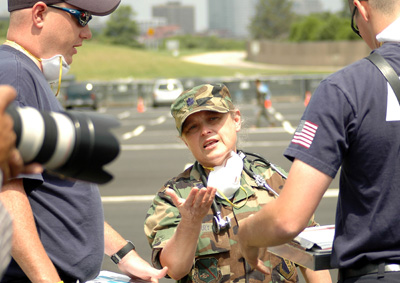
Officials from area fire, emergency medical service, and police departments; military members; and members of the Pentagon Force Protection Agency participated in the exercise, which included decontamination and medical processing of exercise "victims."
Gallant Fox is an opportunity to put training to the test for those who would be first to get involved in handling a disaster situation, said Jim Aiken, a spokesman with the Pentagon Force Protection Agency.
"The value is twofold," he said. "One, you get to practice the procedures you have developed for this kind of incident. And two, you get to meet your counterparts to find out who you would meet on the field in this kind of incident. You get to know them and build trust and confidence in their ability to do their job, and they in you."
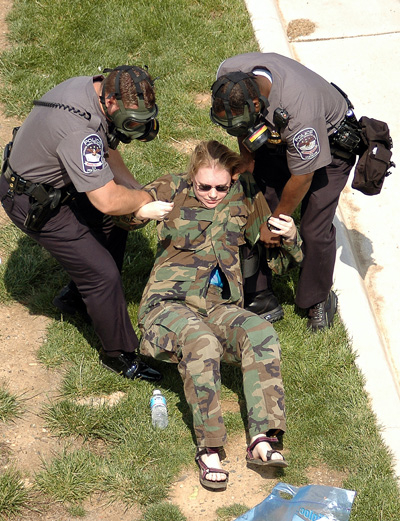
Around 11 a.m., exercise victims of an anthrax attack filed out into the north parking lot at the Pentagon, where first responders were pre-staged to handle decontamination.
"The people who are coming out, who are contaminated, are taking their clothes off, which takes a large amount of the contamination off," Mr. Aiken said. "We send them through the shower and get them to wash their hair and body, so all of the anthrax they could possibly get off, is off."
While exercise participants were not actually exposed to any anthrax spores, the exercise served to test how well local first responders would be able to process the decontamination of affected individuals. Exercise coordinators watched to see how thoroughly first responders adhered to decontamination procedures, and how quickly "victims" could be decontaminated.
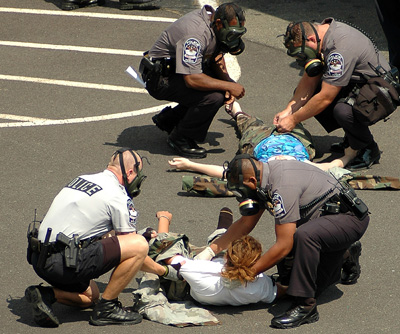
The anthrax attack victims were put through the decontamination process, which involved removing most of their clothes and going through a portable shower unit. A real attack would require all clothing to be removed for proper decontamination.
If the Pentagon were actually the target of an anthrax attack, there could be a larger number of victims that might need to be decontaminated instead of just the 60 exercise participants. But the procedures during the exercise wouldn't be much different than what would happen in real life, Mr. Aiken said.
"We hope we wouldn't do a whole lot different than what we are doing here," he said. "We are going to deal with each individual as though he or she were contaminated."
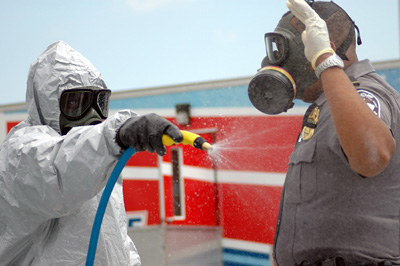
Following decontamination, the victims were triaged. In a real-world anthrax attack, everybody who could possibly have been affected would be treated with some medication as a precautionary measure from the anthrax spores they might have inhaled.
"We want to make sure that the people here, if it is really a possibility, have the protection they need to go home comfortably and that their families are comfortable with the situation," said Dr. Reuben K. Varghese, health director for the Arlington County Public Health Division.
Tests for actual anthrax infections would be used to determine if additional actions are necessary, he said.
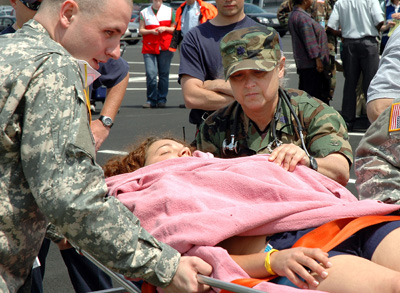
"You have time while the confirmatory tests come back and it allows the military as well as local public health to stand up efforts to do something larger, if we need it," Dr. Varghese said.
Some of the victims of the mock anthrax attack were instructed to act out symptoms of someone who was acutely affected by anthrax spores. Some coughed, some choked, some complained of chest pains, and two had seizures. Those victims were given immediate care on site and some were transported to local area hospitals.
Lt. Col. (Dr.) Marilyn D. Perry acted as the on-scene medical director for the exercise. She and a team of enlisted coworkers from the Pentagon's DiLorenzo Tricare Health Clinic handled distribution of initial anthrax medicines and arranged for transport to area hospitals for those affected most by the anthrax spores.
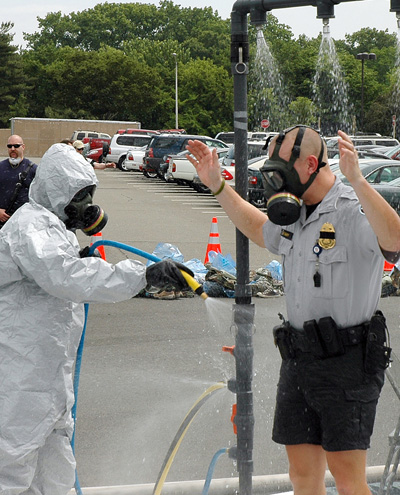
Dr. Perry said by participating in the exercise, she and her team hoped to learn and improve their patient triage procedures during a disaster and how to better navigate through the construction at the Pentagon if a real emergency happened. She also said she hoped to become more acquainted with working with local civilian first responders during an emergency.
"I think we learned how to work more in conjunction with our Arlington counterparts," she said. "And they really do a fantastic job. They are the people to transport (victims) out that we need to depend on."
The total exercise lasted less than two hours, but the cooperation between local area first responders further strengthened the District of Colombia area's ability to respond to a disaster, said James Schwartz, Arlington County Fire Department chief.
"I think this morning represents another great opportunity for the Pentagon and the region's resources -- public health, fire, EMS -- to work together and flesh out some of the issues that remain challenges for us," he said. "We want to make sure, as we go forward in the planning, that both the Pentagon and the county plans are integrated, we understand what the other is doing, and we work together, as in the past. We have identified issues we think need continued work, but we are very pleased with the outcome."
Some of those issues, he said, involve command and control, communications between agencies and how to handle mass patient decontaminations during adverse weather conditions.
"This is the best-prepared region in the country," he said. "The level of collaboration among jurisdictions, among major entities like the Pentagon, and across the professional boundaries like fire, EMS and law enforcement, you will find no better example in the entire country than what is going on here."